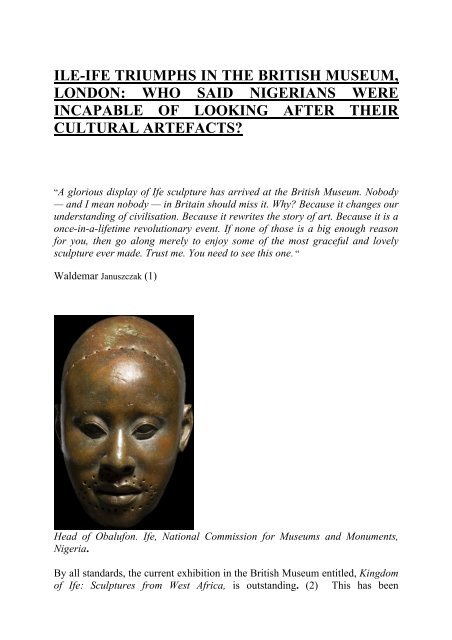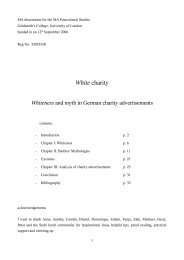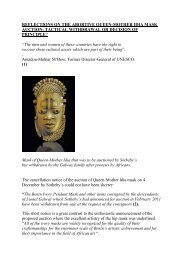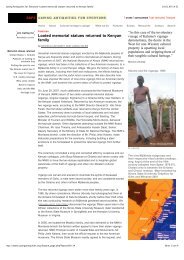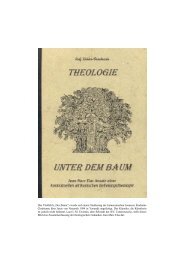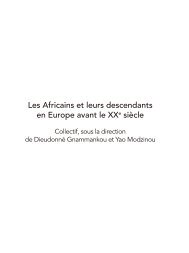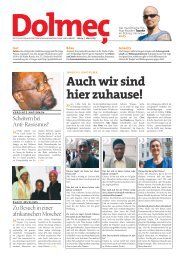ILE.IFE.TRIUMPHS IN BRITISH MUSEUM - Afrikanet.info
ILE.IFE.TRIUMPHS IN BRITISH MUSEUM - Afrikanet.info
ILE.IFE.TRIUMPHS IN BRITISH MUSEUM - Afrikanet.info
Create successful ePaper yourself
Turn your PDF publications into a flip-book with our unique Google optimized e-Paper software.
<strong>ILE</strong>-<strong>IFE</strong> <strong>TRIUMPHS</strong> <strong>IN</strong> THE <strong>BRITISH</strong> <strong>MUSEUM</strong>,<br />
LONDON: WHO SAID NIGERIANS WERE<br />
<strong>IN</strong>CAPABLE OF LOOK<strong>IN</strong>G AFTER THEIR<br />
CULTURAL ARTEFACTS<br />
“A glorious display of Ife sculpture has arrived at the British Museum. Nobody<br />
— and I mean nobody — in Britain should miss it. Why Because it changes our<br />
understanding of civilisation. Because it rewrites the story of art. Because it is a<br />
once-in-a-lifetime revolutionary event. If none of those is a big enough reason<br />
for you, then go along merely to enjoy some of the most graceful and lovely<br />
sculpture ever made. Trust me. You need to see this one. “<br />
Waldemar Januszczak (1)<br />
Head of Obalufon. Ife, National Commission for Museums and Monuments,<br />
Nigeria.<br />
By all standards, the current exhibition in the British Museum entitled, Kingdom<br />
of Ife: Sculptures from West Africa, is outstanding. (2) This has been
acknowledged by most critics and commentators. The British press is full of<br />
praises and enthusiasm. An article by Jonathan Jones, entitled, “The divine art of<br />
the Kingdom of Benin” in The Guardian bears a headline declaring:<br />
“Harmonious and humane, the sculptures of this lost African city have a<br />
greatness that any civilisation would recognise. “<br />
The same writer states in another article in The Guardian:<br />
“This is an exceptional exhibition, even by the high standards the British<br />
Museum has established in recent years. It is extraordinary because it brings<br />
together such a large number of masterpieces that have rarely or never been<br />
exhibited outside Nigeria before – and when I say masterpieces, I mean<br />
artworks that rank with the Terracotta Army, the Parthenon or the mask of<br />
Tutankhamun as treasures of the human spirit.”<br />
“What we see here is an African classical art – by which I mean an art with a<br />
strong concept of order that gives it a special authority, whether it comes from<br />
Athens, China or Ife. Like that of ancient Egypt, the art of Ife is perfect, remote,<br />
godlike and yet – as with Egypt – when you look again it is highly observational,<br />
rooted in the real life of this lost civilisation.”(3)<br />
Michael Glover, in The Independent declared: “At the same historical moment<br />
that Andrea del Verrocchio was doing his wonderfully painstaking, high-<br />
Renaissance drawing of a female head which can be seen elsewhere in this<br />
building, anonymous artisans in Ife were working with brass, bronze – yes, these<br />
Africans knew all about bronze casting long before the Europeans arrived to<br />
show them how – copper and terracotta to produce a series of exquisite heads<br />
that are not only the equal of Donatello in technical brilliance, but also just as<br />
naturalistic in their refinement. So much for African primitivism.” (4)<br />
The Art Newspaper acknowledges that:<br />
“the impact of these extraordinarily naturalistic works continues to resonate<br />
today” (5)<br />
Richard Dorment describes in The Telegraph the quality of the sculptures as<br />
flabbergasting:<br />
“This is the first show ever devoted to the sculpture of Ife anywhere in the<br />
world. The quality of the full length statues, portrait heads, ritual objects and<br />
vessels loaned by Nigeria’s National Commission for Museums and Monuments<br />
is flabbergasting. What can I say Shows like this come along once in a<br />
lifetime.” (6)<br />
Stephen Terence Welsh, Curator of Living Cultures at The Manchester Museum<br />
has described the Ife Crowned Head, in possession of the British Museum,<br />
shown as part of the exhibition as follows:<br />
2
“This exquisite brass sculpture was one of the most important archaeological<br />
discoveries of the 20th century, it revolutionised the way academics and artists<br />
interpreted Africa. It is an iconic example of Yoruba artistry and engineering."<br />
(7)<br />
The exhibition consists of some 100 impressive objects from Ile-Ife, the ancient<br />
spiritual city of the Yoruba in Nigeria loaned by the National Commission on<br />
Museums and Monuments of Nigeria. These outstanding objects are clear<br />
testimony to the extraordinary richness of Nigerian and African culture. Many<br />
Africans in the Diaspora, especially in Brazil, look upon Ife as their spiritual<br />
home and use the Yoruba language in their religious ceremonies that are largely<br />
based on Yoruba traditions.<br />
It seems every generation of Westerners has to “discover” the extraordinary<br />
beauty and sophistication of African culture even though Europe and Africa<br />
have been in contact, at the latest, since 15 th century when the Portuguese sailed<br />
along the West Coast of Africa. It is true though that since then much of the<br />
relations between the two neighbouring continents has been taken up with the<br />
nefarious Slave Trade and the hateful racist colonialism. These two determining<br />
factors do not make for honest appreciation of the arts of Africa. Obviously, if<br />
you are going to enslave a people and exploit their resources, both human and<br />
natural, you are not tempted to praise the technical sophistication of their arts or<br />
the excellence of their craftsmen. Thus in all areas of culture Africans have<br />
been depicted as primitive and savage by Westerners who should have<br />
recognized at first glance that the achievements of the African peoples compare<br />
very well with those of others, including those of the Romans and the Greeks<br />
which are held in highest esteem by Westerners. Instead the label “primitive”<br />
has been attached to all things African - language, religion, music, dance and art.<br />
Westerners have denied to Africans the basic qualities that make us human:<br />
ability to express ourselves and reflect on our environment. This negation results<br />
in subsequent frequent astonishment that our arts are as good as those from other<br />
parts of the world. Ironically, many who proclaim we are primitive and that our<br />
arts are to be put in a different category from those of the rest of humankind<br />
have been very busy stealing and looting our artefacts. Thus, there is hardly a<br />
respectable museum in the Western world that does not have many African<br />
artefacts, the best having been stolen in the colonial days.<br />
3
Torso of a king, Wunmonije Compound, Ife,<br />
Museums and Monuments Nigeria.<br />
National Commission for<br />
The lavish praises which African exhibitions receive in the Western world<br />
cannot be attributed solely to the beauty of our arts and to the excellent<br />
craftsmanship of our artists even though both are deservedly admired. The<br />
denigration of all things African surely contributes to this excitement and<br />
astonishment. Many Westerners have considered and still consider Africans,<br />
contrary to all reality and evidence, as incapable of creative art at the highest<br />
level. The denigration of the African has a long European tradition going back to<br />
the philosophers of the so-called Enlightenment who brought much darkness to<br />
our relationship with Europe. Hegel, Kant, Fichte, Hume, Locke, Montesquieu,<br />
Voltaire and many others were apostles of European superiority who laid the<br />
theoretical foundations for European imperialism and racism. There seems to<br />
have been more respect for Africans and African culture until slavery,<br />
colonization, and the Enlightenment set in. The philosophers and scholars<br />
developed theories of evolution setting up a hierarchy of human development in<br />
which they put the Europeans on top and the Africans at the bottom. European<br />
art at the time, basically naturalistic representation, was made the standard by<br />
which others were to be measured. African art seen as abstract or conceptual,<br />
was put at the bottom and downgraded as primitive and poor attempt at the<br />
imitation of nature. Ironically, when Western artists sought ways of escaping the<br />
restrictions of their so-called classical art standards, they found a way out in<br />
African art to free themselves from the constraining European norms of<br />
naturalism and adopted the freer African style of abstraction. African art offered<br />
4
more freedom of creation and inspired Braque, Derain, Epstein, Giacometti,<br />
Kandinsky, Kirchner, Klee, Matisse, Moore, Modigliani, Nolde, Picasso,<br />
Vlaminck and others. It is true though that the naturalism of these magnificent<br />
Ife sculptures is in great contrast to the more abstract forms of African art,<br />
especially sculpture, which inspired the modern European artists.<br />
“Olokun”, crowned head, Ife, National Commission for Museums and<br />
Monuments, Nigeria<br />
Some of our contemporary Western scholars who have imbibed the cultural<br />
foundations laid by the European Enlightenment, however modified in the<br />
course of time, have views that are not very far removed from those of their<br />
predecessors. In any case, not many seem to be in a hurry to denounce the old<br />
ideas of inherent European superiority. Indeed, many such as James Cuno and<br />
Neil MacGregor who attribute the origin of the “museum concept” to the<br />
European Enlightenment base their arguments for the retention of looted<br />
artefacts on similar undeclared assumptions of inherent Western superiority. In<br />
the absence of such assumptions, they would have no leg to stand on in trying to<br />
defend Western despoliation of Africa.<br />
Some may be taken in by the lavish praises of the Ife exhibition. But did we not<br />
in the past hear similar praises for the Benin artefacts Have Westerners not<br />
equally praised Egyptian, Ethiopian, Malian and generally art from West Africa<br />
and Central Africa How come Westerners are constantly surprised by art from<br />
the African Continent How come so many writers declare their unfamiliarity<br />
or that of their compatriots with African art, including Ife art That many<br />
Westerners are not familiar with Ife art raises very interesting questions. What<br />
5
have the museums been doing in all the hundreds of years they have been<br />
keeping African art The museums have argued against restitution on the ground<br />
that more people see African art in their “great” museums than in Nigeria,<br />
Ghana, Egypt, Ethiopia etc. but it turns out that most of their people know very<br />
little about African art. Museums in Berlin, Frankfurt, London, New York, Paris<br />
and other Western cities have Ife and other African art but even critics and<br />
journalists admit lack of familiarity with Ife art. The exhibition shows an article<br />
in1948 in the Illustrated London News with headlines such as “African art<br />
worthy to rank with the finest works of Italy and Greece” and “Donatellos of<br />
Medieval Africa”. Many of those reviewing the current exhibition - Kingdom of<br />
Ife; Sculptures from West Africa” have been saying more or less the same things.<br />
Has nothing happened to improve the knowledge of Westerners about African<br />
art in the last sixty years What about the works of Ekpo Eyo, Frank Willet,<br />
Leo Frobenius and others What about all those Ife artefacts that Frobenius<br />
brought to Europe and sold to museums and private collectors to finance his<br />
travels Has the important contribution of African art to modernism via the<br />
cubists and the expressionists not helped to make African art more familiar to<br />
Europeans Why must African art and culture remain forever an unknown factor<br />
to Westerners although they have looted and stored in their museums some of<br />
the best art ever produced on our continent Or will this habit of declaring lack<br />
of familiarity with African culture as a way of introduction to general<br />
pronouncements only end when the Western museums have got all our artefacts<br />
locked in their museums A well-known museum director of a famous museum<br />
in New York has argued that since his museum did not possess Nok terracotta<br />
sculptures, he could not recognize one that was depicted in a photo in an article.<br />
His museum possessed thousands of African sculptures but he had been unable<br />
to obtain Nok terracotta from Nigeria. The implication of his argument was that<br />
only African artefacts in Western museums can be known by the general public<br />
and apparently recognized by the museum directors.<br />
Leo Frobenius encountered or, to follow Western terminology, “discovered“ Ife<br />
art in 1910. He attributed the works he saw to some lost Greek tribe since he<br />
could hardly believe that those were the works of Africans. Wole Soyinka, in his<br />
1986 Nobel Lecture, criticized Frobenius for his schizophrenic view of Yoruba<br />
art and the Yoruba. Frobenius was overwhelmed by the beauty of Ife art:<br />
"Before us stood a head of marvellous beauty, wonderfully cast in antique<br />
bronze, true to the life, incrusted with a patina of glorious dark green. This was,<br />
in very deed, the Olokun, Atlantic Africa's Poseidon."<br />
But the same Frobenius also expressed contempt for the people he met at Ife:<br />
"I was moved to silent melancholy at the thought that this assembly of<br />
degenerate and feeble-minded posterity should be the legitimate guardians of so<br />
much loveliness.” (8) Ekpo Eyo, leading authority on Ife and Nigerian art,<br />
writes that Frobenius was astonished by the quality of Ife sculptures and<br />
observed that they were “eloquent of symmetry, vitality, a delicacy of form<br />
6
directly reminiscent of ancient Greece and proof that once upon a time, a race,<br />
far superior in strain to the Negro had settled there”. (9)<br />
Frobenius on arrival at Ife set about to collect artefacts but even the British<br />
colonialists had to restrain him in his collection frenzy. He wanted to take away<br />
a crowned head, “Ori Olokun” but was prevented from doing so by the British<br />
colonial administration which had received complaints from people of Ife about<br />
the activities of the German ethnologists. Still he managed to take many<br />
artefacts away that are now in the Frobenius Institute in Frankfurt, and in the<br />
Ethnology Museum, Berlin, Germany.<br />
Glenn Penny writes in his book, Objects of Culture: Ethnology and<br />
Ethnographic Museums in Imperial Germany as follows:<br />
“During his travels in Nigeria in 1911, Frobenius came into direct conflict with<br />
the British authorities concerning his collecting policies in what has come to be<br />
known as the Olokun Affair. This incident developed following complaints by the<br />
inhabitants of Ife, the sacred capital of the Yoruba country in southern Nigeria<br />
that Frobenius had mistreated and deceived them, and had taken away religious<br />
objects without their consent. The principal item in dispute was the bronze head<br />
of the god Olokun, which Frobenius claimed to have “discovered” in a groove<br />
outside the walls of Ife, but which the town’s inhabitants accused him of<br />
stealing. As a result of the complaints, which followed Frobenius’s departure<br />
from the city British authorities summoned him before an improvised British<br />
court and eventually forced him to return many of the items he had acquired<br />
from the area”. (10)<br />
The original “olokun” that Frobenius saw in 1910 has mysteriously disappeared.<br />
Ekpo states: “The original “Olokun” head described by Frobenius is now<br />
represented only by a copy; no one knows where the original is. It is not<br />
impossible that Frobenius could have arranged for its subsequent replacement<br />
with a copy.” (11)<br />
Frobenius inspired Leopold Sedar Senghor and Aimé Césaire in their writings<br />
on Negritude. Many may share Soyinka’s view that Frobenius was a plunderer.<br />
He donated to Frakfurt some 4700 artefacts. Did he buy them all For a<br />
European to be arrested in those days by the British colonial authorities on<br />
suspicion of having stolen artefacts, he must have been involved in some very<br />
shady business. We have the greatest respect for the founders of Negritude<br />
even though we cannot share an ideology or doctrine that attributes to Africans<br />
thinking processes that are different from those of Europeans, one based on<br />
emotion and the other on rationality. How can great writers such as Senghor and<br />
Aimé Césaire accept, even for a moment, such a basic racist distinction between<br />
human beings Were they aware that Frobenius described the educated Africans<br />
7
he met at the West Coast of Africa as “degenerate trouser-niggers and parasitic<br />
Negro clerks” (12)<br />
The example of Frobenius shows that admiration for African art does not<br />
exclude contempt for African peoples. It is like some Westerners who love<br />
Africa because of the fauna, others because of the animals but hate or despise<br />
African peoples.<br />
This excellent Ife exhibition which is being held in the citadel with the most<br />
looted Nigerian and African artefacts demonstrates, beyond doubt the fallacies<br />
of the arguments advanced as justifications for not returning looted African<br />
artefacts. Surely, the main argument that Nigerians and Africans are not capable<br />
of looking after their artefacts cannot be repeated after this exhibition, if ever<br />
such evidence were necessary. Almost all the objects on show, excluding those<br />
already in the possession of the British Museum, came from Nigeria. Who<br />
looked after them in Nigeria Some Americans and British or Nigerians Of<br />
course, Nigerians cannot protect their artefacts against the onslaught of a wellequipped<br />
army with traditions of looting cultural artefacts.<br />
Requests for restitution of looted artefacts have generally fallen on deaf ears.<br />
The British Museum with which the Nigerians have organized this exhibition<br />
has refused to return, among others, the Benin bronzes which were looted by the<br />
British army in the nefarious “punitive expedition“of 1897. The invading army<br />
massacred innocent women and children, executed the Benin king’s close<br />
advisers, burnt Benin City and sent the Oba of Benin, Ovonramwen into exile.<br />
Demands for restitution have not till this day been satisfied. On the contrary,<br />
British Museum has sold some of the Benin bronzes to others and to the<br />
Nigerian Government. The museum has also refused to return to Nigeria, even<br />
for a short period, the ivory hip mask of Queen-Mother Idia which had been<br />
chosen as symbol for FESTAC 1977 (Second World African Festival of Arts<br />
and Culture ) and thus obliged the Africans and Nigerians to produce a new<br />
version. As Sylvester Ogbechie stated, the famous hip pendant mask of Queen<br />
Mother Idia, was taken from the belt of Oba Ovonramwen after his surrender to<br />
the invading British forces. The king was made to kneel down in front of the<br />
British military resident of the town and rub his forehead thrice on the ground.<br />
(13) The humiliation of Ovonramwen is the humiliation of Benin, Nigeria and<br />
Africa. The hip-mask in the British Museum symbolizes the defeat, humiliation<br />
and powerlessness of Africans and is not merely an object of aesthetic<br />
contemplation. But do the people at the British Museum and the British<br />
Government care for the feelings of Nigerians and other Africans<br />
Critics have written about the Ife exhibition as if Ife and Benin were not<br />
connected. Here I am not referring to the traditional connection between the two<br />
cultures. According to tradition, Oba Oguala of Benin requested from the Oni of<br />
8
Ife that a bronze caster be sent from Ife to teach the method of casting an<br />
instructor in bronze casting. (14) Critics have written laudable reviews about the<br />
Ife exhibition without mentioning the ongoing discussion about restitution of the<br />
Benin Bronzes. (15) No doubt many Westerners would prefer to concentrate on<br />
the exhibition at hand and forget about an issue which shows up the hypocrisy of<br />
present-day Westerners and the nefarious acts of their predecessors. But can<br />
Africans also adopt such an attitude Can we pass over in silence the insult to<br />
the whole African continent by the refusal of the British Museum even to “lend”<br />
the ivory hip mask of Queen-Mother Idia for FESTAC Incidentally, with<br />
regard to the present exhibition, we do not hear from the Nigerians any<br />
expressions of doubt that the objects lent to the British Museum would be taken<br />
care of or that they would be returned or that they are too delicate to travel; the<br />
usual explanations we are used to hearing from that museum when it has to lend<br />
any object or return an object to its country of origin even if for a short period.<br />
Also, insurance of the objects does seem to have been a problem for this<br />
exhibition.<br />
The British Museum denies that any request has been made for the Benin<br />
Bronzes even though a petition has been made to the British Parliament. (16)<br />
Countless Nigerian institutions, including the Nigerian Parliament, have at one<br />
time or another expressed the wish to have the Benin Bronzes return home but to<br />
no avail. One may wonder whether the Nigerian Commission on Museums and<br />
Monuments which has been organizing exhibitions with Western museums ever<br />
raises the issue. We have no published accounts of their efforts in this regard.<br />
Whatever strategy is being pursued here has not been very successful and it is<br />
time to consider a change of approach. One may reflect on the fruitful approach<br />
of Zahi Hawass, the dynamic Secretary-General of the Supreme Council of<br />
Antiquities (Egypt). Since he took charge of that body in 2003, Egypt has<br />
recovered some 30,000 artefacts, including the recent batch of 25 thousand<br />
artefacts from the University of London, a neighbour to the British Museum in<br />
Bloomsbury, London. (17)<br />
This exhibition which started in Spain and is now in London will go to the<br />
United States in August but sad to say, it will not go to Ife or to any other<br />
Nigerian or African city. We ask again a question already raised elsewhere. (18)<br />
Do the people of Ife and other Nigerian towns not need to see the Ife artefacts<br />
It seems this exhibition is following the pattern laid down by the Benin<br />
exhibition. (19) Do other Africans have no need to see Nigeria’s cultural<br />
objects Are we going to establish African unity in ignorance of the culture of a<br />
country like Nigeria with 159 million inhabitants<br />
To the question why the touring exhibition will not go to Africa, here is the<br />
answer of a curator of the exhibition, Claude Ardouin:<br />
9
“This is due to the specific schedule of this tour. We will eventually work with<br />
our Nigerian partners at the NCMM to show the exhibition in Nigeria. We have<br />
no doubt that there are a number of leading museums on the continent with the<br />
required capacities to host it”.<br />
The editor of NEXT noted: “All attempts by NEXT to get the views and<br />
comments of Nigeria's National Commission for Museums and Monuments<br />
(NCMM) about Kingdom of Ife, failed”. (20)<br />
It is interesting to read what Dr. Joseph Eboreime, former director of the<br />
NCMM stated in this regard in the catalogue of the exhibition: “We hope that<br />
this book, and the exhibition on which it is based, will reach the general public<br />
in Nigeria, the many Nigerians who live beyond our borders, and the<br />
international audiences who will be able to see it in Europe and the United<br />
States”. (21) The possibilities for the realization of this wish should be<br />
examined against the background of a general public that cannot read or write<br />
English and which is more at home in seeing cultural objects and not just<br />
reading about them. Moreover, can the average Nigerian afford to pay for the<br />
catalogue Clearly, an exhibition that will not go to Nigeria and Africa can be<br />
considered, as far as the Nigerian and African publics are concerned as<br />
practically non-existent. Moreover, we should recall that both the United States<br />
and Britain put severe restrictions on the grant of visa to Nigerians and other<br />
Africans. It is excluded that these countries grant a visa to a Nigerian who wants<br />
to enter the country for the sole purpose of seeing the Ife exhibition or the many<br />
Nigerian artefacts produced by his predecessors that are now in those States. So<br />
what does the Nigerian people gain from an exhibition such as the Ife exhibition<br />
which is shown only in Europe and United States of America<br />
Quartz stool from shrine at Oluorogbo, Ife, Nigeria, now in British Museum,<br />
London, United Kingdom<br />
10
According to a press release of the British Museum, “Throughout 2010 the BM<br />
will stage a series of Africa-related events, activities and displays to celebrate<br />
the 50 th anniversary of independence of not only Nigeria (1 October 2010) but of<br />
16 other Africa countries.” (22) That the British Museum and other Western<br />
museums would be arranging exhibitions on Africa and other events to coincide<br />
with the 50 th anniversary of Independence raises some questions. Is this<br />
cynicism or genuine joy and sympathy What grounds do Western museums<br />
have for celebrating African Independence or to join in the festivities marking<br />
the end of the oppressive and racist Western colonial system<br />
Western museums, especially the self-styled “universal museums”, can be<br />
considered as symbolizing the anti-thesis of African Independence. They are the<br />
great beneficiaries of colonial robbery and despoliation. They are the<br />
depositaries of colonial looting and stealing of African artefacts now lying in<br />
their basements and other depots. It is true that some of the fanatic Western<br />
retentionists have argued that museums have nothing to do with the colonial<br />
system but all serious and honest observers recognize the plain and simple<br />
truth: though the umbilical cord between the so-called ”universal museum” and<br />
colonialism may be severed, the fundamental connections are still there. (23) A<br />
quick visit to the Louvre, British Museum, Berlin State Museums, The Royal<br />
Museum for Central Africa, Tervuren (Belgium) and others will confirm this.<br />
In the specific case of Nigeria, a celebration of 50 th anniversary of Independence<br />
by the British Museum is remarkable when we recall that in the last 50 years the<br />
Nigerians Parliament have called for the return of some of the looted artefacts,<br />
especially the Benin Bronzes without any success or even sympathetic hearing<br />
from the British Museum and other Western museums. These calls have been<br />
treated with the utmost contempt. Since the artefacts were looted by the<br />
invading British army, Western museums and their governments have acted as if<br />
it were their God-given right and duty to keep the looted Benin artefacts.<br />
If the British Museum, the Ethnological Museum, Berlin, the Ethnological<br />
Museum, Vienna, the Ethnological Museum, Leiden and other Western<br />
museums want genuinely to celebrate the 50 th Independence of the Nigeria, they<br />
could seize this occasion by making a bold gesture of returning some of the<br />
Benin bronzes. They could at least adopt a more conciliatory approach to the<br />
issue of restitution rather than their traditional arrogant attitude which has no<br />
basis in morality or legality.<br />
A celebration of 50 th Independence anniversary of African States by the Western<br />
museums brings into sharp focus the fact that even after half a century, cultural<br />
artefacts that symbolize political authority still remain with the former colonial<br />
powers that took them away as war trophies and confirmation of their<br />
superiority. These cultural objects should have been returned at the dawn of<br />
11
Independence and yet after half a century there is no sign of a change. Our<br />
inability to recover our cultural objects after decades of Independence cannot<br />
contribute to confirmation of our Independence. On the contrary, it demonstrates<br />
beyond all doubt the hold of the former colonial powers on our countries. Worst<br />
still, the beneficiaries of colonial loot and plunder want to celebrate with us. It is<br />
like a person who has stolen your cds inviting you to your birthday celebration,<br />
suggesting you might bring some Afro-beat hits which he could not take away<br />
on a previous occasion. They want to celebrate with us an anniversary of the<br />
end of colonialism but they do not want to give up any of the benefits of<br />
colonialism. So what do they really want to celebrate<br />
Ile-Ife triumphs in British Museum, London. Will British Museum masterpieces<br />
come to Ife/Abuja Praises are good but actions are even better.<br />
Ilé ahun là npa ahun sí. Yoruba Proverb. (24)<br />
Kwame Opoku, 17 April 2010.<br />
12
Brass head with crown, Wunmonije Compound, Ife, National Commission for<br />
Museums and Monuments, Nigeria.<br />
NOTES<br />
1. Waldemar Januszczak, “This African art is heads above the rest”<br />
http://entertainment.timesonline.couk<br />
Rachel Campbell also declared: “Head sculptures on show at the British<br />
Museum are so stunning that our ancestors said they couldn’t be African”.<br />
http://entertainment.timesonline.co.uk<br />
2. The exhibition, co-organized by the Fundación Marcelino Botin, Santander,<br />
Spain and the Museum for African Art, New York, in collaboration with the<br />
National Commission for Museums and Monuments, Nigeria, has been in<br />
Spain(30 July to 20 September 2009) and is from March 4 to June 6, 2010 in the<br />
British Museum. In Spain and in the USA the exhibition and catalogue are<br />
entitled Dynasty and Divinity; Ife Art in Ancient Nigeria. The travelling<br />
exhibition goes to the United States from September 19, 2010 until April 8,<br />
2011. The exhibition will not be shown in any Nigerian or African city.<br />
3. http://www.guardian.co.uk ; http://www.guardian.co.uk<br />
4. http://www.independent.co.uk<br />
5. http://www.theartnewspaper.com<br />
6. http://www.tele+raph.co.uk<br />
7. http://www.museum.manchester.ac.uk<br />
8. Wole Soyinka, "This Past Must Address Its Present," Nobel Lecture,<br />
December 8, 1986,<br />
http://nobelprize.org/nobel_prizes/literature/laureates/1986/soyinka-lecture.html<br />
9. Ekpo Eyo, Two Thousand Years of Nigerian Art, Ethnographica, London,<br />
1977, p.100.<br />
13
10. H.Glenn Penny, Ethnology and Ethnographic Museums in Imperial<br />
Germany, The University of North Carolina Press, Chapel Hill and London,<br />
2002, p.116.<br />
11. Ekpo Eyo, and Frank Willett, Treasures of Ancient Nigeria, William Collins,<br />
London, 1982, p. 11. Edith Platte writes in Bronze Head from Ife, (The British<br />
Museum Press, 2010, p. 42): “Frobenius was an uninvited if highly experienced,<br />
explorer and ethnologist, visiting Ife for just a few weeks and provoking<br />
arguments with most of the people he encountered. It is quite possible that he<br />
took the head and left behind a replica, as it was suggested in negotiations with<br />
the Oni at that time. However, it could also be the case, as suggested by Willet,<br />
that the reproduction was made sometime between 1910 and 1934, when it was<br />
brought to the palace for safekeeping”.<br />
We have so far no <strong>info</strong>rmation about efforts being made to find the missing<br />
Olokun. Given the apparent importance of this piece of sculpture, one could<br />
imagine that attempts would be made to trace its whereabouts, whether in Berlin<br />
or Frankfurt. We also do not know whether Interpol and other bodies specialized<br />
in tracing lost, looted or stolen objects have been contacted. Or is nobody<br />
interested in discovering how an important artefact seen in 1910 by a famous<br />
German ethnologist who took away lots of objects has disappeared In this<br />
connection, it would be interesting to know which Nigerian artefacts have been<br />
taken away from the country, where they are located and what attempts have<br />
been made to recover them. This would also help to clarify stories one hears<br />
about objects sent out for exhibitions in West that never came back. The<br />
reputation of Westerners is such that most Africans believe they come to our<br />
continent to take whatever they can lay their hands on. Some also remember the<br />
Christian missionaries who ordered that cultural artefacts they described as<br />
heathen be brought to them for destruction only to realize later that many of<br />
them ended in Europe. One recalls Vatican’s request for such artefacts for<br />
exhibition in Rome where half of the objects remain till today. Jeanette<br />
Greenfield comments in her excellent book, The Return of Cultural Treasures<br />
(Third Edition Cambridge University Press, 2007, p.100) as follows:<br />
“A vast collection of ethnological objects is held by the Vatican Ethnological<br />
Museum in Rome. There are more than 60,000 objects, with approximately<br />
10,000 from Africa, 10,000 from the Americas, 20,000 from Asia, 6,000 from<br />
Oceania, and another 15,000 labelled ‘prehistoric’…<br />
“In 1925 Pope Pius XI organized a missionary exhibition extolling missionary<br />
work all over the non-western world. About 100,000 items were sent and after<br />
the exhibition only about half were returned. The Pope proclaimed the<br />
formation of a new museum, the Pontifico Museu Missionario-Etnologico, so<br />
14
that the ‘dawn of faith among the infidel of today can be compared to the dawn<br />
of faith which… illuminated pagan Rome”.<br />
12. Eike Haberland (Ed), Leo Frobenius on African History, Art and Culture,<br />
Marcus Wiener Publishers, Princeton, 2007, p.59. In his enthusiastic foreword to<br />
this book, Leopold Senghor declared: “Now, to celebrate the centenary of his<br />
birth, we have a Leo Frobenius Anthology. The great German ethnologist has<br />
thoroughly deserved this memorial in the second half of the 20 th century, of<br />
which one of the characteristic features will be the emergence of the African<br />
countries on the international scene. For no one did more than Frobenius to<br />
reveal Africa to the world and the Africans themselves”. p.vii.<br />
“It was Leo Frobenius who gave us both the vision and the explanation, at the<br />
very moment when, having completed our studies, we were entering upon active<br />
militant life, with the concept and the idea of Négritude under our belts. It was<br />
Frobenius who helped to give the word its most solid, at the same time its most<br />
human significance.” p.viii.<br />
Sylvester Ogbechie has an assessment of Leo Frobenius which seems fairly<br />
balanced:<br />
“Contemporary scholarship is deeply divided about the legacy of Leo<br />
Frobenius. He was the first Western ethnographer to document some very<br />
important aspects of African art, the first Westerner to publish <strong>info</strong>rmation<br />
about the famous Ife royal sculpture, and he led an important team of scholars<br />
who created meticulous documentation of many forms of African art and culture<br />
during several expeditions to Africa. Nevertheless Frobenius disbelieved the<br />
evidence of his own eyes/experience and tried to claim Ife culture for a mythical<br />
Atlantis. He wrote with grudging respect for the artworks but less consideration<br />
for the people who produced these works. He was very impacted by the racial<br />
ideologies of his time with significant implications for his scholarship but I think<br />
a review of his archives compels respect for the prodigious nature of his<br />
research focus.”<br />
http://aachronym.blogspot.com<br />
It is indeed very difficult not to be impressed by the tremendous amount of<br />
works that Frobenius published and the quality of his output.<br />
13. http://aachronym.blogspot.com For details on the refusal to”lend” to<br />
Nigeria and Africa, the ivory hip-mask of Queen-Mother Idia, see K. Opoku,<br />
“Once in the British Museum, always in the British Museum”,<br />
http://www.modernghana.com See also, Wayne Morrison, Criminology,<br />
15
Civilization and the new World Order, Routledge-Cavindish, Oxon, 2006, pp.<br />
233-242<br />
14. William Bascom, African Art in Cultural Perspective, W.W Norton and Co.<br />
New York, London, 1973, p.22; Ekpo Eyo and Frank Willett, op. cit. p.42.<br />
Enid Schildkrout, Kingdom of Ife; Sculptures from West Africa, p. 44. Frank<br />
Willett, Ife in the History of Qwest African Sculpture, Thames and Hudson,<br />
London, 1967, pp.154-155.<br />
15. For discussions on the restitution of the Benin bronzes, see Peju Layiwola,<br />
Benin 1897 com Art and the Restitution Question, 2010;<br />
Kwame Opoku, “Formal Demand for the Return of Benin Bronzes: Will<br />
Western Museums Now Return Some of the Looted/Stolen Benin Artefacts”<br />
http://www.modernghana.com<br />
Monday Midnite, 1897, http://www.youtube.com)<br />
Crown Fraud: Stolen Benin Bronzes & British Museum<br />
http://www.youtube.com<br />
16. See Annex below.<br />
17. K. Opoku, “Egyptian Season of Artefacts Returns: Hopeful Sign to be<br />
followed by others” http://www.modernghana.com<br />
18. K. Opoku, “Are Major African Art Exhibitions Only for the Western<br />
World” http://www.modernghana.com<br />
19. K. Opoku, “Benin Exhibition in Chicago,” http://www.modernghana.com<br />
20. NEXT, http://234next.com<br />
21. Henry John Drewal and Enid Schildkrout, Kingdom of Ife: Sculptures from<br />
West Africa, The British Museum Press. London, 2010, p. X, Printed in China.<br />
22. http://www.britishmuseum.org<br />
VOANews.com http://www1.voanews.com “The exhibition celebrates the 50th<br />
anniversary of Nigeria's independence. Curator Julie Hudson says it also<br />
highlights just how long and rich is the region's history.”<br />
23. Those who may be tempted to believe or accept that the presence of so<br />
many objects from former British colonies in the British Museum have nothing<br />
to do with the British colonial empire, are advised to read the excellent book of<br />
Annie E. Coombes, Reinventing Africa, Yale University Press, London, 1994.<br />
16
24.” One should make a stand in defence of one’s rights and property, even to<br />
the death.” Oyekan Owomoyela, Yoruba Proverbs. University of Nebraska<br />
Press, Lincoln and London, 2005, p.429.<br />
Queen-Mother Idia, hip mask, Benin, Nigeria, now in British Museum, London,<br />
United Kingdom.<br />
ANNEX<br />
17
APPENDIX 21<br />
The Case of Benin<br />
Memorandum submitted by Prince Edun Akenzua<br />
I am Edun Akenzua Enogie (Duke) of Obazuwa-Iko, brother of His Majesty,<br />
Omo, n'Oba n'Edo, Oba (King) Erediauwa of Benin, great grandson of His Majesty<br />
Omo n'Oba n'Edo, Oba Ovonramwen, in whose reign the cultural property was<br />
removed in 1897. I am also the Chairman of the Benin Centenary Committee<br />
established in 1996 to commemorate 100 years of Britain's invasion of Benin, the<br />
action which led to the removal of the cultural property.<br />
HISTORY<br />
"On 26 March 1892 the Deputy Commissioner and Vice-Consul, Benin District of<br />
the Oil River Protectorate, Captain H L Gallwey, manoeuvred Oba Ovonramwen<br />
and his chiefs into agreeing to terms of a treaty with the British Government. That<br />
treaty, in all its implications, marked the beginning of the end of the independence<br />
of Benin not only on account of its theoretical claims, which bordered on the<br />
fictitious, but also in providing the British with the pretext, if not the legal basis, for<br />
subsequently holding the Oba accountable for his future actions."<br />
The text quoted above was taken from the paper presented at the Benin Centenary<br />
Lectures by Professor P A Igbafe of the Department of History, University of Benin<br />
on 17 February 1997.<br />
Four years later in 1896 the British Acting Consul in the Niger-Delta, Captain<br />
James R Philip wrote a letter to the British Foreign Secretary, Lord Salisbury,<br />
requesting approval for his proposal to invade Benin and depose its King. As a<br />
post-script to the letter, Captain Philip wrote: "I would add that I have reason to<br />
hope that sufficient ivory would be found in the King's house to pay the expenses<br />
incurred in removing the King from his stool."<br />
These two extracts sum up succinctly the intention of the British, or, at least, of<br />
Captain Philip, to take over Benin and its natural and cultural wealth for the British.<br />
British troops invaded Benin on 10 February1897. After a fierce battle, they<br />
captured the city, on February 18. Three days later, on 21 February precisely, they<br />
torched the city and burnt down practically every house. Pitching their tent on the<br />
Palace grounds, the soldiers gathered all the bronzes, ivory-works, carved tusks and<br />
oak chests that escaped the fire. Thus, some 3,000 pieces of cultural artwork were<br />
taken away from Benin. The bulk of it was taken from the burnt down Palace.<br />
NUMBER OF ITEMS REMOVED<br />
It is not possible for us to say exactly how many items were removed. They were<br />
not catalogued at inception. We are <strong>info</strong>rmed that the soldiers who looted the palace<br />
did the cataloguing. It is from their accounts and those of some European and<br />
American sources that we have come to know that the British carried away more<br />
than 3,000 pieces of Benin cultural property. They are now scattered in museums<br />
and galleries all over the world, especially in London, Scotland, Europe and the<br />
18<br />
United States. A good number of them are in private hands.<br />
WHAT THE WORKS MEAN TO THE PEOPLE OF BEN<strong>IN</strong>
than 3,000 pieces of Benin cultural property. They are now scattered in museums<br />
and galleries all over the world, especially in London, Scotland, Europe and the<br />
United States. A good number of them are in private hands.<br />
WHAT THE WORKS MEAN TO THE PEOPLE OF BEN<strong>IN</strong><br />
The works have been referred to as primitive art, or simply, artifacts of African<br />
origin. But Benin did not produce their works only for aesthetics or for galleries and<br />
museums. At the time Europeans were keeping their records in long-hand and in<br />
hieroglyphics, the people of Benin cast theirs in bronze, carved on ivory or wood.<br />
The Obas commissioned them when an important event took place which they<br />
wished to record. Some of them of course, were ornamental to adorn altars and<br />
places of worship. But many of them were actually reference points, the library or<br />
the archive. To illustrate this, one may cite an event which took place during the<br />
coronation of Oba Erediauwa in 1979. There was an argument as to where to place<br />
an item of the coronation paraphernalia. Fortunately a bronze-cast of a past Oba<br />
wearing the same regalia had escaped the eyes of the soldiers and so it is still with<br />
us. Reference was made to it and the matter was resolved. Taking away those items<br />
is taking away our records, or our Soul.<br />
RELIEF SOUGHT<br />
In view of the fore-going, the following reliefs are sought on behalf of the Oba and<br />
people of Benin who have been impoverished, materially and psychologically, by<br />
the wanton looting of their historically and cultural property.<br />
March 2000<br />
(i) The official record of the property removed from the Palace of Benin in<br />
1897 be made available to the owner, the Oba of Benin.<br />
(ii) All the cultural property belonging to the Oba of Benin illegally taken<br />
away by the British in 1897, should be returned to the rightful owner, the<br />
Oba of Benin.<br />
(iii) As an alternative, to (ii) above, the British should pay monetary<br />
compensation, based on the current market value, to the rightful owner, the<br />
Oba of Benin.<br />
(iv) Britain, being the principal looters of the Benin Palace, should take full<br />
responsibility for retrieving the cultural property or the monetary<br />
compensation from all those to whom the British sold them.<br />
http://www.publications.parliament.uk<br />
19


